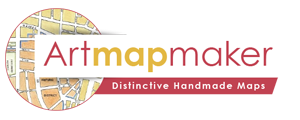Maps are almost always created from existing maps. I use public domain maps, changing the elements and scale, to create an outline and "skeleton" of a new map. For example, "Manhattan and its Neighborhoods" was based on a famous old map by Viele from 1874 that describes the hydrology of Manhattan. The linear elements of the map are traced onto tracing paper, then transillluminated on a light table. The form is traced again onto high quality art paper that can take ink. Then the tracing is hand-inked using various pens, straightedges and curves. Once the linear elements are drawn, the lettering is added using mechanical lettering. Leroy mechanical lettering is a traditional system that uses hard templates with incised letters.
Pantograph
A pantograph device has a fine pin that fits into the incised letter. Its other end is a pen tip. The pin traces the outline of the letter and its shape is duplicated with the pen tip, creating fine lettering on the map. Once the inking is complete, color is applied with colored charcoal. The color is softened with a stomp, an instrument of rolled paper that looks like a pencil. This is rubbed over the color to create the rich, soft colors of the final map. The map is then sprayed with a fixative to protect the surface.
How We Photograph The Map
Once the original is complete (which takes hundreds of hours), I bring it to a professional photographer who uses a camera with a Better Light high-resolution tri-linear CCD digital back mounted on a 4 x 5 body to photograph the map. This digital file is then used to print the map, using a Vutek HS 3200 UV-cured inkjet printer by EFI on HP matte Litho-Real paper (or equivalent.)
This process allows the duplication of hand-made maps that is quite faithful to the originals. I would even say that the prints look better than the originals; the colors are brighter. I am very happy to offer these for sale.
